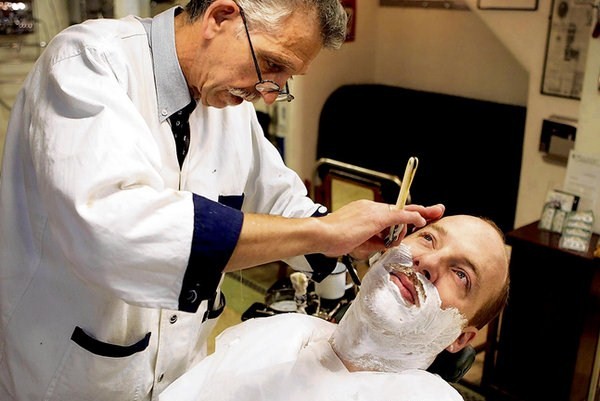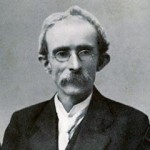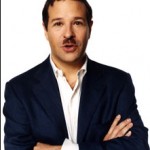Blog
Published: Irish Times, November 1 2011The art and science of feeling foolish

In the cavernous saloon of the Waldorf Barbershop, Liam Finnegan is leafing through a book entitled The Art and Science of Barbering. It is basically a retro Argos catalogue of facial hair. And he’s pitching me ideas. “The Divided Handlebar?” he offers. “The Modified Handlebar? The Painter’s Brush? The Nightshade?”
The Nightshade looks dangerously close to The Hitler, I suggest. “Oh no, no,” he furrows his brow and flicks forward a few pages until he finds what he is looking for. “That would be The Adolph.” Christ. How old is the book? He shrugs his shoulders. “Old.” Finnegan has been running the Waldorf since 1969, when he took the business over from his father. As he lathers me up for a hot towel shave, I notice a fluffy white caterpillar sneaking across his own upper lip. What’s that one called, I inquire? He tuts softly. “I wouldn’t normally wear the moustache this long,” he says. “But they persuaded me to grow it out. You know, for this Movember thing.”
Ah, yes. Today is the first day of “Movember”: the annual charity drive to raise funds and awareness for men’s health issues, specifically for prostate cancer, by undertaking the arduous task of growing a moustache. Since it debuted in Ireland in 2008, Movember (the word is a clumsy portmanteau of “moustache” and “November”) has grown exponentially. Last year, it raised a record €1.6m for the Irish Cancer Society.
For participants, the rules are simple. Each “Mo Bro” (as volunteers are rather cringingly referred to) begins November 1st with a clean shaven face. For the duration of the month, he must grow and groom a moustache. Growing a full beard and then shaving it down to a moustache at the end of the month is prohibited. Thus most “Mo Bros” will spend at least a fortnight with embarrassing piece of bum fluff hovering below their nose.
Not to worry, promise the organisers. Even the worst moustache makes for an interesting conversation piece. (Unless one opts for the Adolph, of course, in which case I imagine it makes for a heated conversation piece.)
Beyond that the world of the “Mo Bro” becomes slightly more opaque. “Each Mo Bro must conduct himself like a country gentleman,” is another rule. “The Mo Bro is dedicated to the cause of fine moustachery. He is aware of his responsibility to honour the moustache.” The website is filled with bizarre slow motion videos of moustachioed men standing in the fields staring solemnly at the camera, while slogans like “The Pride” and “The Craft” flash past. It’s all nonsense, of course, but it helps fosters a sense of camaraderie among participants.
The genius of Movember, it seems, is not an ability to attract donations, but rather an ability to attract recruits. Last year, the average Irish “Mo Bro” raised a relatively modest €133 per tache. But because 12,700 signed up, that amounted to a very respectable €1.6m for charity. Anecdotal evidence, meanwhile, suggests that others took part in growing their moustaches for the month but never signed up to the campaign and never raised any donations.
This in turn leads to an enormous amount of free publicity for the cause (this article included.)
Yet for all the positives to be celebrated, there are reasons to feel ambivalent about Movember. The problem, obviously, is not that it raises lots of money for a very good cause. Donating to charity is something we all should do as often as we can, for any excuse or none at all. Nor do is there anything objectionable about facial hair. (The month hasn’t even started yet and already my face is a living monument to the possibilities of the art form!)
What’s troubling about Movember is what it seems to say about our generation. In Ireland, this is a generation who jumped onto the property ladder because that’s what we were told to do. Who are trapped in negative equity, but deign to raise a word in protest as the banks responsible for the crisis are bailed out. And even on the silliest, most asinine level, this is a generation that quite clearly yearns to experiment with facial hair. But somehow we require the sanction of participation in Movember.
There is something very sad and Prufrockian about this: Movember is a fashion form letter for a generation too timid to make a fashion statement.
So here’s my pitch… If one intends to solicit charitable donations from strangers, one should be prepared to endure, if not great physical exertion or privation, then at the very least inconvenience and mild discomfort. Other “mo bros” who come looking for your cash this month will be doing something easy that they fancy doing any anyway. It might as well be a sponsored lie-in. They do make love to their employment.
But I find everything about Movember embarrassing in the extreme. I would rather claw my eyes out than be mistaken for someone who is dedicated to the cause of fine moustachery. I would rather re-sit my Leaving Cert than engage in moustache-related small talk on the Luas. Anyone kind enough to donate at the link below, therefore, can be therefore assured that I am resenting, and feeling demeaned by, every single minute of it.
Oh, and it’s all for a very good cause!
THE BOXCAR
Celebrity exponents: Tom Selleck, Ian Botham, Willie Joe Padden
Pro: Requires zero grooming.
Con: Loses a certain cachet when referred to as The Willie O’Dea.
 In its 1970s heyday, the boxcar was redolent of a certain breed of tough guy. This was the moustache favoured by firemen, lumberjacks and sportsmen. Indeed, of the famous Liverpool side of the early 1980, five first team members were aficionados. (Go on, have a go if you think you can name them all…) So synonymous with machismo was this iconic piece of face furniture, in fact, that it was eventually appropriated as a symbol of the gay rights movement. Gay or straight though, it’s long overdue a comeback.
In its 1970s heyday, the boxcar was redolent of a certain breed of tough guy. This was the moustache favoured by firemen, lumberjacks and sportsmen. Indeed, of the famous Liverpool side of the early 1980, five first team members were aficionados. (Go on, have a go if you think you can name them all…) So synonymous with machismo was this iconic piece of face furniture, in fact, that it was eventually appropriated as a symbol of the gay rights movement. Gay or straight though, it’s long overdue a comeback.
THE POIROT
Celebrity exponents: Diego Velasquez, Salvadore Dali, Snidely Whiplash
Con: Denotes vanity, eccentricity and fastidiousness.
Pro: And how!
 “It has always been my weakness to desire to show off,” confessed Hercule Poirot in Mrs McGinty’s Dead. “Indeed it is necessary for a man of my abilities to admire himself.” For Agatha Christie, this ludicrous lip toupee was intended to signify a forensic attention to detail on the part of her hero. The more outlandish variant sported by Salvador Dali, meanwhile, suggested flamboyance and a desire to be noticed. Today, the organisers of Movember are trying to plot a comeback for this most derided style. But it looks to be a bridge too far.
“It has always been my weakness to desire to show off,” confessed Hercule Poirot in Mrs McGinty’s Dead. “Indeed it is necessary for a man of my abilities to admire himself.” For Agatha Christie, this ludicrous lip toupee was intended to signify a forensic attention to detail on the part of her hero. The more outlandish variant sported by Salvador Dali, meanwhile, suggested flamboyance and a desire to be noticed. Today, the organisers of Movember are trying to plot a comeback for this most derided style. But it looks to be a bridge too far.
THE PENCIL
Celebrity exponents: Errol Flynn, Frida Kahlo, filmmaker John Waters
Pro: Brad Pitt pulled this look off in Inglorious Bastards.
Con: Breaking news… You’re not Brad Pitt.
 Sported most recently by Bob Dylan, the Pencil is a sort of low maintenance, utilitarian alternative to the Poirot. This is a moustache that says “I’m a cad, I’m a bounder, I cheat at cards and I’m not to be trusted around men or women… But can I really be bothered with all that waxing?”
Sported most recently by Bob Dylan, the Pencil is a sort of low maintenance, utilitarian alternative to the Poirot. This is a moustache that says “I’m a cad, I’m a bounder, I cheat at cards and I’m not to be trusted around men or women… But can I really be bothered with all that waxing?”
THE WALRUS
Celebrity exponents: Mark Twain, 1916 leader Tom Clarke, Sam Elliot
Con: Surprisingly absorbent.
Pro: Renders you impervious to lip readers. Possibly.
 Unless you’re auditioning for the role of innkeeper in an upcoming Western, there really is nothing to recommend the Walrus. I speak from personal experience here. The problem with having hair hanging down over your lip is that it absorbs pretty much everything you attempt to eat or drink. If your whiskers fall into a pint of Guinness, for example, then you won’t need a napkin, you’ll need a bathroom towel. The following morning you’ll be wandering around the house wondering, why does everything smell of curry chips?
Unless you’re auditioning for the role of innkeeper in an upcoming Western, there really is nothing to recommend the Walrus. I speak from personal experience here. The problem with having hair hanging down over your lip is that it absorbs pretty much everything you attempt to eat or drink. If your whiskers fall into a pint of Guinness, for example, then you won’t need a napkin, you’ll need a bathroom towel. The following morning you’ll be wandering around the house wondering, why does everything smell of curry chips?
THE TOOTHBRUSH
Celebrity exponents: Charlie Chaplin, Oliver Hardy, er…
Pro: Technically, this moustache was never an accessory to any crime.
Con: …but even still.
 Ironically, for a moustache now synonymous with the worst excesses of totalitarianism, this aerodynamic effort was conceived in the early twentieth century as a way of thumbing one’s nose at authority. (The great and good, in those days, tended to sport very elaborate moustaches.) Throughout the 1910s, and 1920s, The Toothbush the rode the crest of a wave of popularity, boosted by its associationg with loved funny men like Charlie Chaplin and Oliver Hardy. But Hitler came along and the Toothbrush became a pariah moustache.
Ironically, for a moustache now synonymous with the worst excesses of totalitarianism, this aerodynamic effort was conceived in the early twentieth century as a way of thumbing one’s nose at authority. (The great and good, in those days, tended to sport very elaborate moustaches.) Throughout the 1910s, and 1920s, The Toothbush the rode the crest of a wave of popularity, boosted by its associationg with loved funny men like Charlie Chaplin and Oliver Hardy. But Hitler came along and the Toothbrush became a pariah moustache.

November 3rd, 2011 at 9:26 am
Eoin: Hilarious as always. Keep ’em coming!
The only time I ever tried to grow a mustache and a beard (many years ago), my then-2-year-old daughter soon discovered they were a great way to “steer” me where she wanted to go when I was carrying her around at the grocery store — she’d grab hold & pull HARD to make sure I went STRAIGHT TO THE CANDY AISLE….
November 3rd, 2011 at 1:36 pm
Which of the above will you be cultivating Eoin?